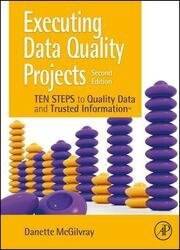 Название: Executing Data Quality Projects: Ten Steps to Quality Data and Trusted Information (TM), 2nd Edition
Название: Executing Data Quality Projects: Ten Steps to Quality Data and Trusted Information (TM), 2nd EditionАвтор: Danette McGilvray
Издательство: Academic Press
Год: 2021
Страниц: 378
Язык: английский
Формат: pdf (true)
Размер: 32.8 MB
Executing Data Quality Projects, Second Edition presents a structured yet flexible approach for creating, improving, sustaining and managing the quality of data and information within any organization.
Studies show that data quality problems are costing businesses billions of dollars each year, with poor data linked to waste and inefficiency, damaged credibility among customers and suppliers, and an organizational inability to make sound decisions. Help is here! This book describes a proven Ten Step approach that combines a conceptual framework for understanding information quality with techniques, tools, and instructions for practically putting the approach to work - with the end result of high-quality trusted data and information, so critical to today’s data-dependent organizations.
The Ten Steps approach applies to all types of data and all types of organizations – for-profit in any industry, non-profit, government, education, healthcare, science, research, and medicine. This book includes numerous templates, detailed examples, and practical advice for executing every step. At the same time, readers are advised on how to select relevant steps and apply them in different ways to best address the many situations they will face. The layout allows for quick reference with an easy-to-use format highlighting key concepts and definitions, important checkpoints, communication activities, best practices, and warnings. The experience of actual clients and users of the Ten Steps provide real examples of outputs for the steps plus highlighted, sidebar case studies called Ten Steps in Action.
This book uses projects as the vehicle for data quality work and the word broadly to include: 1) focused data quality improvement projects, such as improving data used in supply chain management, 2) data quality activities in other projects such as building new applications and migrating data from legacy systems, integrating data because of mergers and acquisitions, or untangling data due to organizational breakups, and 3) ad hoc use of data quality steps, techniques, or activities in the course of daily work. The Ten Steps approach can also be used to enrich an organization’s standard SDLC (whether sequential or Agile) and it complements general improvement methodologies such as six sigma or lean. No two data quality projects are the same but the flexible nature of the Ten Steps means the methodology can be applied to all.
The new Second Edition highlights topics such as artificial intelligence and machine learning, Internet of Things, security and privacy, analytics, legal and regulatory requirements, data science, big data, data lakes, and cloud computing, among others, to show their dependence on data and information and why data quality is more relevant and critical now than ever before.
Скачать Executing Data Quality Projects: Ten Steps to Quality Data and Trusted Information (TM), 2nd Edition